#sonju is the only reasonably dressed person
Explore tagged Tumblr posts
Text
The climate in Neverland I
Forests and wasteland
DISCLAIMER: I am far from an expert on this topic. I don’t know anything about weather stuff. I predict the weather by looking out the window and I have been called out multiple times for not knowing what is and what is not winter clothing. Do not blindly trust me
This post is focused on the climate and weather in the forests and wastelands. Goldy Pond, the farms and the capital will get their own posts.
@puff-poff tried to figure out what the climate in Neverland could be based on how the demons dress. Unfortunately, the demons all dress for different weather circumstances. Sonju ruins everything
My approach is going to be the opposite of Puff’s, I am going to ignore the demons and focus on the children. Mainly on how the groups of children dress for the weather and how they feel. This way individual outliers Sonju will not make this harder than it already is
The timeline made by @just-like-playing-tag was heavily used for this. Thank you for making it, it was very helpful!
I am the least trustworthy source on what clothes should be worn at what temperature so outside temperatures are estimated with this guide by getoutsideandplay.ca. The guide shows recommendations for how to dress a child at what temperatures.

With these tools in hand, let’s go on an adventure
Part I: The forest (1)
The kids are dressed in rather light clothing. Long pants, collared shirt, sweater and a scarf. This may be what they had to make do with from the clothes that were available at Gracefield. The children started their escape at the night of 15th of january. The children moved throughout the night and did not have to light a fire to stay warm.

Despite the young kids complaining about the cold the next day, they don’t show any (serious) hypothermia symptoms.

The kids being cold in this part of the forest is explained by the trees blocking sunlight from coming in.
The clothing the children wear is very similar to the clothing that the guide recommends children to wear when it is 0C to 10C outside.
It might have been a little colder in the forest as the children did add a scarf to their outfit and were complaining about the cold.
Weather wise, there is a slight breeze but no snow or rain of any kind. There is flowing water (a river) in the forest and there are trees.
Part II: The wasteland
On the 22nd of january the children meet Yuugo in the shelter. Who promptly threatens to kick the group out into the wasteland.

Which is a problem because the clothes the children have may not be warm enough. It makes sense for the wasteland to be colder (at night), there is nothing to retain heat. This article explains why that is the case in more detail. Just like in the forest, there is no rain or snow shown in the wasteland.
There are no trees, rivers or lakes in the wasteland.

Fortunately the kids find some better clothing in the shelter. Boots, long pants, a long sleeved shirt of some kind and a coat. These outfits are similar to the outfits the clothing/temperature guide recommends for -10C to 0C.
Part III: Seven walls search
When a small group of kids departs to search for the seven walls on the 10th of march they wear the same kind of clothing. The group returns in july in the same clothing. They return in february only to leave again and return in october. While on this journey the kids travel across the demon world in the same clothes.
However, it is very possible that the kids may have temporarily removed or added clothes when the weather required it.
There is a brief snippet of the kids wearing demon disguises over their normal outfits in september. However, those disguises are only temporarily and the children don’t wear them while travelling through forests and wastelands.
Funnily enough, the story mostly takes place in the autumn/winter months. Summer gets skipped over. I guess Shirai wanted to make the children suffer from everything but heatstroke, that’s nice.
Part IV: The forest again
After Andrew attacks the children are back out in the forest again. Fortunately for them it is october and not january. The enormous group is able to walk through the forest in just light clothing. Boots, long pants a collared shirt and maybe maybe an undershirt is enough to keep them warm. These clothes are similar to the clothing recommended for about 10C in the clothing guide.

Part V: Another forest
Don and Gilda go look for Sonju and Musica on the 2nd of november. During this search they wear boots, long pants a coat and a collared shirt underneath. This outfit is similar to the outfits the children wore in the wasteland except maybe a little colder.
Which means that the outside temperature is a few degrees higher than-10C to 0C. Let’s say 3 degrees C higher, which would make it -7C to 3C.
There is no rain or snow shown but there are trees. Musica can be seen drinking from a stream.

Conclusion
january 0C to 10C in the forest, a little breeze january -10C to 0C in the wasteland, no weather shown throughout the year across the world, at least -10C no weather shown october 10C in the forest again, no weather shown november -7C to 3C in another forest, no weather shown
The climate in Neverland has mild winters with little to no rain or snow. The summer climate is largely unknown.
There are trees and rivers/streams present in the world of Neverland.
This information can then be used to find the most fitting climate for Neverland. The type of climate is picked based on the Köppen classification.
These temperatures and the lack of precipitation fits with what we call a cold desert climate. The temperature chart below shows that the monthly temperatures roughly line up with the estimates from Neverland
January in the forest doesn’t really but that could also be due to the kids not wearing the right clothing (clothing suited for 0C to 10C).

The temperature chart was measured in the city Leh. Fortunately for me Leh has trees and a river, showing that it is possible for trees and rivers to exist in such a climate.

This is not perfect but it is the best I could find so if anyone has any other ideas, tell me
Sources/references
Clothing/temperature guide http://getoutsideandplay.ca/wp-content/uploads/2020/05/How-to-Dress-for-the-Weather-STANDARD.pdf
Desert temperature at night https://www.scienceabc.com/nature/why-do-deserts-get-cold-at-night.html
Köppen classification https://en.wikipedia.org/wiki/K%C3%B6ppen_climate_classification
Cold desert climate https://en.wikipedia.org/wiki/Desert_climate#Cold_desert_climates
#good thing the guide exists#for reasonable winter clothing#otherwise i'd have said tpn takes place in the actual arctic#why else would people wear so many layers#in this climate#sonju is the only reasonably dressed person#yeh i said that#promised climate#the promised neverland#tpn#silly post#there's so many climates holyshit#damn you köppen classification
32 notes
·
View notes
Text
The Culture of the Demon World
One part of The Promised Neverland that I always wanted to learn more about was the demons and their culture. Demons are a whole new race with their own language, religions, traditions, food, and history, and I want to learn more about their society. So, I decided to do a bit of research on a few specific aspects of the demon world. After writing everything down and connecting the pieces while trying to remain true to canon, I finally have something clear enough to share with you all.
Without further ado, I present to you my analysis of demon culture.
Part One: Clothing Just like in real life, the clothing demons wear depends on their social status and wealth. The middle and lower-class demons wear loose, flowing clothes with wide collars and sleeves. They most likely do this just in case they aren’t able to eat human meat and maintain their form; baggy clothes won’t tear if the demons start to degenerate. This is why the wealthy demons wear tighter clothing. Tight-fitting outfits show that you can afford plenty of human meat and that you aren’t worried about degenerating.
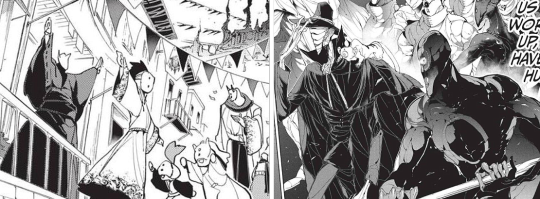
Many demons, both poor and rich, wear long, layered clothing, but it’s hard to tell if this is a societal standard or a byproduct of cold weather. Almost all of the demons we see are wearing long-sleeved tops and ankle-length bottoms, as well as a jacket, shawl, cape, or scarf. However, the feet and hands are almost always uncovered.
A major part of demon clothing is, of course, their masks. This extra page explains the styles and functionality of the Goldy Pond demon’s masks:
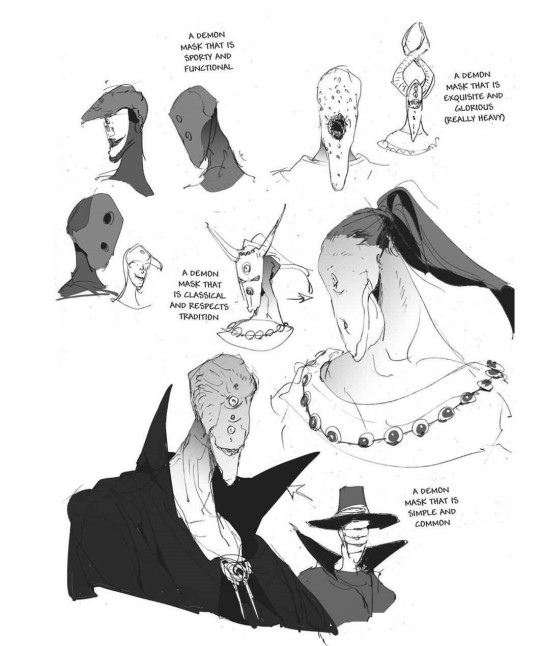
Like the rest of their clothing, wealth plays a part in demon’s masks as well. Detailed masks with large horns, like Luce’s, are worn by rich demons who want to flaunt their wealth, while lower-class demons wear simple, paneled masks with short horns. Demons who want a more functional mask might choose one without horns so they don’t get in their way. The aristocrat demons also have a unifying feature between their territory’s masks to differentiate themselves from the leaders of other territories. Whether or not your mask shows your mouth appears to be a personal preference since Legravalima, Mujika, Sonju, Awla, and Mawla all have uncovered mouths despite the character’s drastic differences.

Another detail I would like to point out is the material of the masks. Most demon masks are likely made of a material similar to clay, but there are a few demons with special masks that appear to be made out of something else. Nous and Nouma, for example, have athletic masks coated with shiny material that’s probably similar to polyester. However, it was Legravalima and Sonju’s masks that interested me the most. Legravalima’s mask is smooth, glossy, and seemingly made out of metal. A metallic mask is likely a sign of royal status and immense wealth. This explains why Sonju had a metallic mask as a child, and why he doesn’t have one now. When he was a prince, Sonju wore a shiny mask with a design similar to Legravalima’s. After running away with Mujika, he grew out of his mask and now wears a clay one of the same design.

This might just be the art style of the series changing over time, but I also find it interesting that Sonju’s mask suddenly becomes glossy in chapter 156 during the battle at the royal capital. It’s his first time stepping foot in the palace since he ran away, and it’s as if his mask is suggesting that returning to the palace has given Sonju his royal status back.
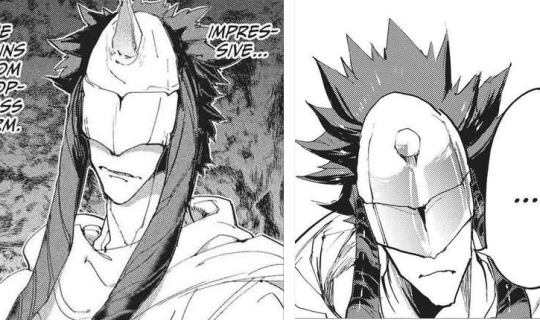
Part Two: Architecture In many ways, the architecture in the demon world reminds me of places like the Sant Francesc Church in Spain and Royal Ontario Museum in Canada. As time goes on, old buildings are expanded and improved with modern additions to accommodate the changing world. This can be seen in the paradise hideout, where a newer building was constructed next to the original settlement.

The old, traditional demon buildings are made of clay and other types of stones. They don’t appear to have many windows, and the few windows they do have are holes without window panes. Many of the older buildings were carved out of mountains or trees, or at least rest atop a mountain with steps carved into the side. This traditional style of demon architecture is similar to old Pueblo architecture and adobe homes.
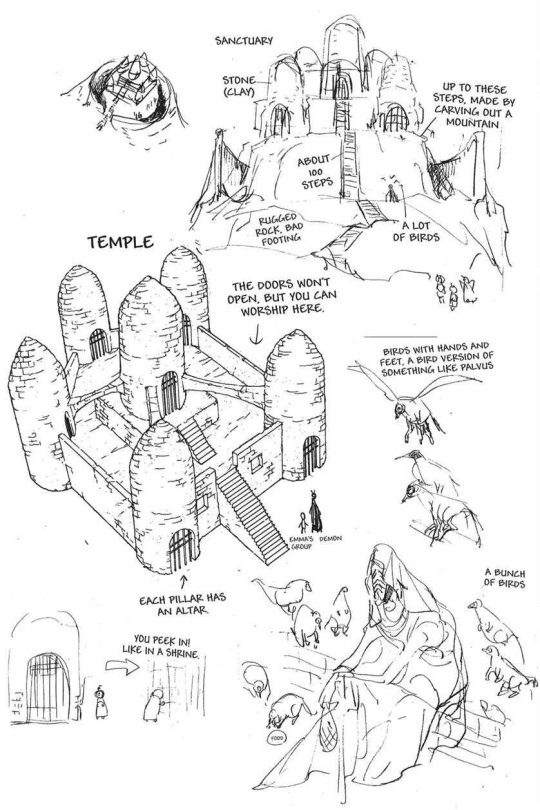
The newer demon architecture likely came into style sometime before Goldy Pond was built, seeing as Goldy Pond has buildings similar to those in modern demon villages. It resembles the European Tudor style with its grid window panes, timber frames, and sloped roofs. The walls were probably made using the wattle and daub technique and painted white or cream. Some of the buildings have stone foundations, but unlike the old style of architecture, the stones are laid like bricks. Buildings made using the new style of architecture also have shutters, awnings, and Juliet balconies.

This picture of the royal capital’s streets perfectly shows the mixing of the old and new architectural styles:

Here, you can see the original clay buildings with the balconies, awnings, and wooden frames of the new style added on. The buildings in the foreground have open windows while the ones further back have grid panes. One of the structures on the right is built in the style of the older demon homes, but it uses modern stone bricks and balconies. This blend of architecture helps show the development of the demon society through the years.
Part Three: Food Human meat is the most important food in demon culture since it’s what keeps the majority of demons from degenerating. I won’t be talking a lot about the farms and human meat in this post since it’s already been explored by the manga and people smarter than me. If you want to read more about demons and human meat, I recommend this post by the-silliest-idiot and this translation of the fanbook, particularly the Q&A sections.
As explained in the manga, the appearance of demons changes depending on the type of meat they eat. The aristocrat demons eat human meat, Parvus eats monkey meat, and the demon horse Sonju rides eats horse meat. As explained in the fanbook, humanoid demons will lose their human appearance if they don’t eat human meat, but monkey demons like Parvus can retain their appearance for a while. To keep themselves from degenerating or changing forms, humanoid demons don’t eat a lot of meat other than the human meat from the farms. When the demons do eat other meats, they eat bugs, fish, and birds, probably because those animals are difficult to change into.
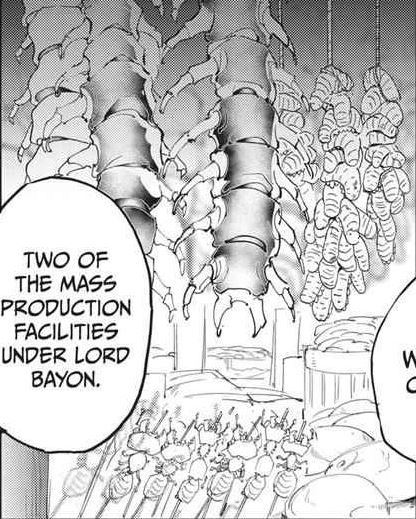
While it’s unclear if demons eat the plants in the forest, we know that there are plenty of edible berries, nuts, fungi, and other plants that the human escapees eat during their travels. Demons also have a variety of fruits, vegetables, and nuts that they grow and harvest. In just these two panels, we can see that the demons have their own versions of pears, hazelnuts, pineapples, kiwi, and mangos (the mangos seem to be popular in the royal capital).

All demons, regardless of wealth or social status, appear to have equal access to all food except human meat. Lower-class demons get low-quality meat, but the same berries and nuts being sold at street markets are present in the Tifari offering.
Part Four: Language Unfortunately, I’m not smart enough to decode the old demon language. In the words of the fanbook, “Sugita created demon god's name, but every other text from the demon language that appeared afterward was Posuka's creation.” The language was made up by Posuka, and I’m not sure if there’s enough dialogue to translate a full alphabet. The old demon language looks like a combination of Japanese and Enochian, but that’s all I can gather from it. It’s also unclear if the language has a written form.
However, the old demon language isn’t used anymore. The language died out for two major reasons; a general lack of knowledge and to separate language from the old faith. The aristocratic demons know the language well enough, but we don’t see many commoner demons speaking it. The modern demon society writes in English, as shown by the signs at Goldy Pond, and it’s likely that they also speak English despite the story being written in Japanese. There's also a chance that the demons speak Old English since the promise was forged during medieval times. If this is true, then the aristocrats and heads of the farms could have a more modern accent because they often talk to people from the human world.
Part Five: The Arts Sadly, we don't know much about art in the demon world. The promise was made around the 11th century, so art in the demon world is likely reflective of that time. I can only assume they have their own literature, art movements, and music, but it's mostly speculation. One thing I noticed is that the demon world has a lot of embroideries, whether it be on the edges of a cape or banners inside the palace. This fits with my theory of medieval Europe-inspired art and languages. During medieval times, top layer garments such as coats and cloaks were commonly embroidered along the hemline and cuffs. This kind of embroidered clothing is worn by many demons throughout the series.
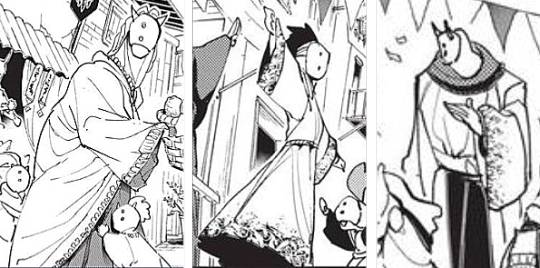
Banners, tapestries, and flags were also commonly created by artists during medieval times. Lines of flags are seen throughout the demon world, and a few buildings in the capital have banners hanging outside. The palace has a few banners of its own, though they're fancier than the ones in the capital streets.
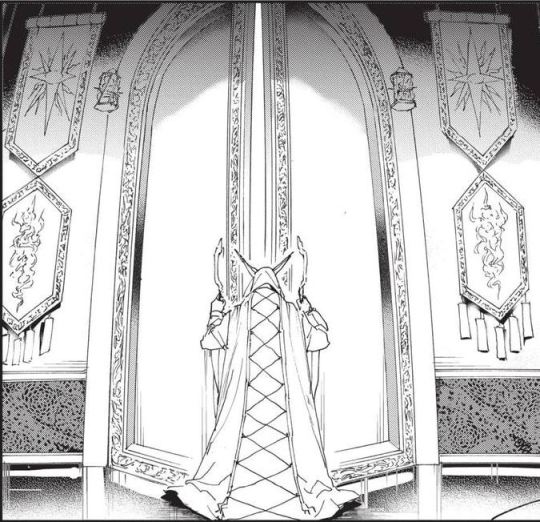
Damask fabric is another example of demon artistry being influenced by medieval Europe. Damask is a reversible fabric created by weaving. The royal demons seem to have jumped on the damask train before the promise was sealed because it can be found in many places throughout the palace. Most notably, Legravalima's dress is partially made of damask, though the silhouette is very different from that of a medieval damask evening gown. Damask was commonly used to make curtains as well, like the ones draped around the Tifari offering.
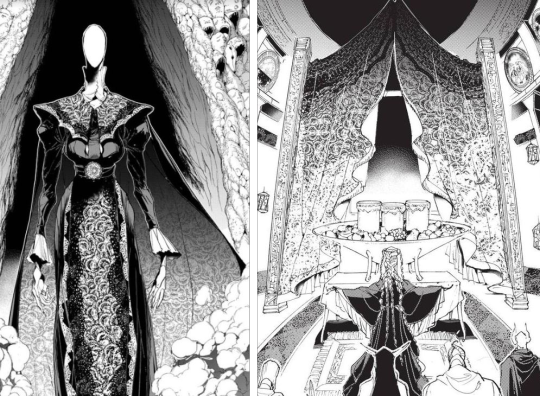
We don’t know much about literature in the demon world. The books we see were written in the human world and sent to the farms, but surely the demons have their own books and stories. Seeing as the rest of the arts in the demon world were inspired by medieval Europe, I can only assume that their books, fables, and plays are as well. Much of medieval literature was based on religion and chivalry. There were also many fables and myths derived from old stories and religious texts. Demon children probably read many stories about the Evil Blooded, the runaway prince, and heroic knights who protect the demons from harm. There likely are many stories written in the old demon language as well. Similar to Latin and Old English in the Middle Ages, the old demon language was probably the main written language until the 11th century, when the demons began using English as a primary language.
I imagine that Anglo Saxon, Byzantine, and Norman (ha get it) art heavily inspired art in the demon world. The palace is likely covered in tapestries and murals depicting historic events. Metal and tilework were probably once a major part of demon artistry, but the practices died out over time. Instead, many demon artists practice painting and embroidery. Pieces of art in the demon world would be very vibrant and colorful, especially the works displayed in the palace.
When it comes to music in the demon world, there isn’t much to go off of. We know that the farms have access to instruments and sheet music because of Leslie and Nat. Barbara also sings a Japanese children’s song in chapter 113. Unfortunately, we don’t get much information about music in the demon world outside of the farms. I assume that demons primarily play string instruments and piano because of their long fingers. They also have more fingers than humans, meaning they can make a variety of chords that humans can’t. More fingers also allow demons to add more strings to their instruments. Even though it’s possible that demons have their own special instruments, we know that they also have human instruments like cellos, trumpets, and pianos.

Conclusion: There’s a lot more I wish I could talk about (mainly the elements of culture), but I’m stopping for now so this doesn’t get any longer. Feel free to correct me or add on anything I missed. If you made it this far, thank you for reading this incredibly long analysis of demon culture and I hope you have a great day.
#am I reading into this too much? yeah#the promised neverland#the promised neverland manga spoilers#tpn#yakusuko no neverland#ynn
90 notes
·
View notes